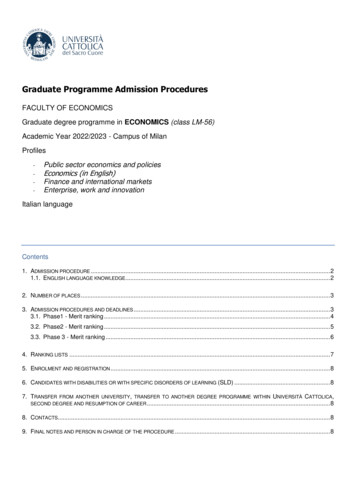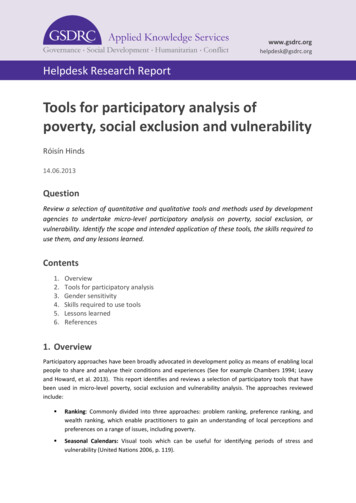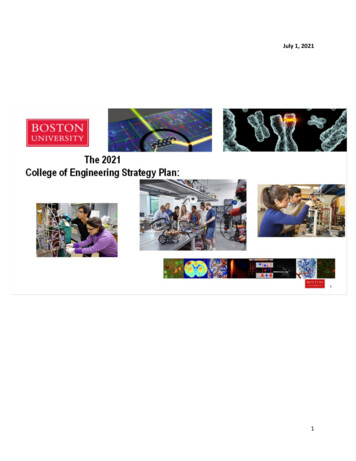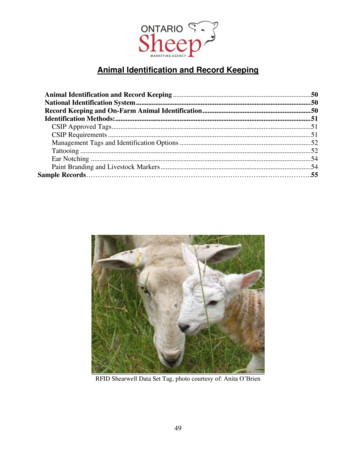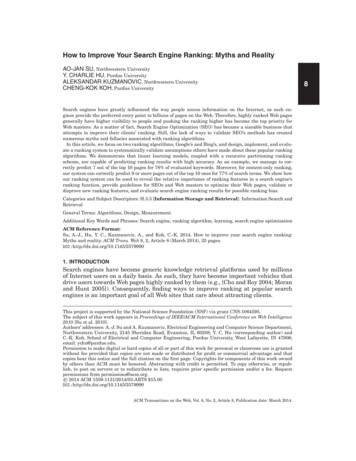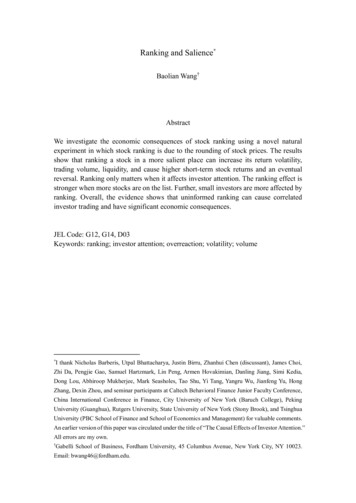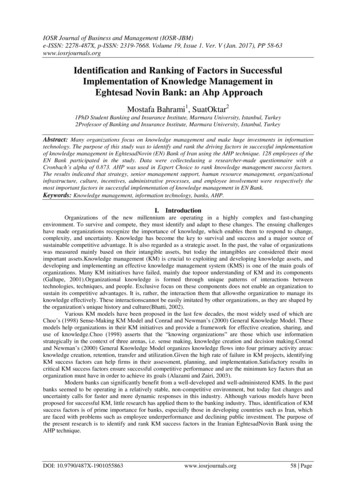
Transcription
IOSR Journal of Business and Management (IOSR-JBM)e-ISSN: 2278-487X, p-ISSN: 2319-7668. Volume 19, Issue 1. Ver. V (Jan. 2017), PP 58-63www.iosrjournals.orgIdentification and Ranking of Factors in SuccessfulImplementation of Knowledge Management inEghtesad Novin Bank: an Ahp ApproachMostafa Bahrami1, SuatOktar21PhD Student Banking and Insurance Institute, Marmara University, Istanbul, Turkey2Professor of Banking and Insurance Institute, Marmara University, Istanbul, TurkeyAbstract: Many organizations focus on knowledge management and make huge investments in informationtechnology. The purpose of this study was to identify and rank the driving factors in successful implementationof knowledge management in EghtesadNovin (EN) Bank of Iran using the AHP technique. 128 employees of theEN Bank participated in the study. Data were collectedusing a researcher-made questionnaire with aCronbach’s alpha of 0.873. AHP was used in Expert Choice to rank knowledge management success factors.The results indicated that strategy, senior management support, human resource management, organizationalinfrastructure, culture, incentives, administrative processes, and employee involvement were respectively themost important factors in successful implementation of knowledge management in EN Bank.Keywords: Knowledge management, information technology, banks, AHP.I. IntroductionOrganizations of the new millennium are operating in a highly complex and fast-changingenvironment. To survive and compete, they must identify and adapt to these changes. The ensuing challengeshave made organizations recognize the importance of knowledge, which enables them to respond to change,complexity, and uncertainty. Knowledge has become the key to survival and success and a major source ofsustainable competitive advantage. It is also regarded as a strategic asset. In the past, the value of organizationswas measured mainly based on their intangible assets, but today the intangibles are considered their mostimportant assets.Knowledge management (KM) is crucial to exploiting and developing knowledge assets, anddeveloping and implementing an effective knowledge management system (KMS) is one of the main goals oforganizations. Many KM initiatives have failed, mainly due topoor understanding of KM and its components(Gallupe, 2001).Organizational knowledge is formed through unique patterns of interactions betweentechnologies, techniques, and people. Exclusive focus on these components does not enable an organization tosustain its competitive advantages. It is, rather, the interaction them that allowsthe organization to manage itsknowledge effectively. These interactionscannot be easily imitated by other organizations, as they are shaped bythe organization's unique history and culture(Bhatti, 2002).Various KM models have been proposed in the last few decades, the most widely used of which areChoo’s (1998) Sense-Making KM Model and Conrad and Newman’s (2000) General Knowledge Model. Thesemodels help organizations in their KM initiatives and provide a framework for effective creation, sharing, anduse of knowledge.Choo (1998) asserts that the “knowing organizations” are those which use informationstrategically in the context of three arenas, i.e. sense making, knowledge creation and decision making.Conradand Newman’s (2000) General Knowledge Model organizes knowledge flows into four primary activity areas:knowledge creation, retention, transfer and utilization.Given the high rate of failure in KM projects, identifyingKM success factors can help firms in their assessment, planning, and implementation.Satisfactory results incritical KM success factors ensure successful competitive performance and are the minimum key factors that anorganization must have in order to achieve its goals (Alazami and Zairi, 2003).Modern banks can significantly benefit from a well-developed and well-administered KMS. In the pastbanks seemed to be operating in a relatively stable, non-competitive environment, but today fast changes anduncertainty calls for faster and more dynamic responses in this industry. Although various models have beenproposed for successful KM, little research has applied them to the banking industry. Thus, identification of KMsuccess factors is of prime importance for banks, especially those in developing countries such as Iran, whichare faced with problems such as employee underperformance and declining public investment. The purpose ofthe present research is to identify and rank KM success factors in the Iranian EghtesadNovin Bank using theAHP technique.DOI: 10.9790/487X-1901055863www.iosrjournals.org58 Page
Identification and Ranking of Factors in Successful Implementation of Knowledge Management inII. Literature ReviewAlavi and Leidner (2001) stressed the importance of cultural factors in KM success. Culture is definedas a set of values, beliefs, norms, meanings, and procedures shared by organization members (Robbin, 2004).Organizational culture shapes and guides the behavior of the organization’s members and affects their responseto different situations (Mavondo and Farrell, 2004). Each organization has a unique culture, which not onlydetermines the type of knowledge that is created, but also its capacity for achieving competitive advantage.According to Alavi and Leidner (2001), successful KM lead to better decision-making, faster response time,improved productivity, and reduced costs. Therefore, a knowledge-oriented culture is a key KM enabler and canincrease management commitment to undertaking KM initiatives.De Long and Fahey (2000) studied the cultural barriers to knowledge management in more than 50companies pursuing knowledge management projects. They found that, while, most managers intuitivelyrecognize the importance of culture, they find it difficult to articulate the relationship of their existing culture toKM objectives. According to Ruppel and Harrington (2001), knowledge must be viewed as a process rather thanan asset, because then the emphasis is on creating a proper environment to enable and facilitate the flow ofinformation. They also suggested that people-based issues such as culture can be a potential barrier to effectiveimplementation and use of knowledge.Similarly, Bhatt (2011) and Pauleen andMason (2002) reported culturaland management factors as the main potential barriers to successful KM implementation.McManus andLoughridge (2002) investigated the relationship between corporate information, institutional culture andknowledge management in UK university libraries. They found that culture and structure were major factorsaffecting perceptions of the relevance of knowledge management programs and projects. Davenport et al. (1998)have identified eight knowledge management success factors: technology infrastructure; organizationalinfrastructure; balance of flexibility, evolution, and ease-of-accessibility to knowledge; shared knowledge;knowledge-friendly culture; motivated workers who develop, share and use knowledge; means of knowledgetransfer using various information technology infrastructure; and senior management support and commitment.Wong and Aspinwall(2005) identified 11 KM success factor: leadership and support; culture; informationtechnology; strategy and purpose; measurement; organisational infrastructure; processes and activities;motivational aids; resources; training and education; and human resource management.Chourides et al. (2003),Mathi (2004), and Khalifa and Liu (2003) consider having strategy and purpose as a key factor in KM success.Moreover, Tiwana (2000) proposed four primary KM success factors: KM and business strategy alignment;knowledge map development; knowledge assets audit; and KM team design.EidandNuhu (2011) examined the impact of learning culture and information technology use on knowledgesharingin Saudi universities. They found a significant positive relationship between learning culture, IT use, andknowledgesharing.Kumar and Ganesh (2009) provided a morphology of the research literature on knowledge transfer inorganizations. 8 dimensions were found suitable to characterize the knowledge transfer research literature:study, knowledge, agents, flow, mechanism, contextual factor, geography, and business context.Asgari (2013) carried out a study to identify and rank the factors in implementation of knowledge managementusing the TOPSIS approach. A questionnaire was developed based on the model proposed by Bukowitz andWilliams (Get, Use, Learn, Contribute, Assess, Build/Sustain, and Divest). The results showed all these factorsaffected KM implementation.Huang and Lai (2012) examined the critical success factors for KM in the life insurance industry.Seven factors were identified: environments, individual characteristics, KM characteristics, organizationalcharacteristics, IT infrastructure, cultural factor, and KM implementation. The results showed that: (1)environments significantly affect organizational characteristics; (2) environments and IT infrastructuresignificantly affect KM characteristics; and (3) individual characteristics, KM characteristics and organizationalcharacteristics significantly influence KM implementation. Gonzalez and Martins (2014) studied on Mappingthe organizational factors that support knowledge management in the Brazilian automotive industry .The resultsshowedthat :the most important factors are respectively as follows: Human resources; teamwork; organizationalculture; organizational structure; and development and absorption of knowledge. Bahrami et al. (2016) studiedon Identification and Ranking of Factors in Successful Implementation of Knowledge Management inTürkiyeişBankası: An AHP Approach . They identified 8 KM success factor. The results showed that : the mostimportant factors are respectively as follows: Strategy; senior management support; organizationalinfrastructure; incentives; human resource management; culture; administrative processes; and employeeinvolvement.DOI: 10.9790/487X-1901055863www.iosrjournals.org59 Page
Identification and Ranking of Factors in Successful Implementation of Knowledge Management inIII. MethodologyPopulation and SampleThis research was a descriptive survey, covering the first half of 2015. The population consisted of allthe branches of EghtesadNovin (EN) Bank in Tehran (N 90). Using cluster sampling, 4 employees (with thehighest experience and academic degree) were selected from 8 branches in each of the 4 regions of the city(sample size 128).IV. InstrumentData were collected using a questionnaire that consisted of two section. The first section recorded thedemographic data (i.e. gender, position, experience, and education). The second section included a pairedcomparison part for the identified factors (i.e. strategy, senior management support, organizationalinfrastructure, incentives, human resource management, culture, and administrative processes) and a part wherethe components of each factor were compared pairwise. This questionnaire is developed to identify and rank thefactors in successful implementation of KM in EN Bank. It uses the AHP technique which is based on pairwisecomparisons. Face validity of the instrument was evaluated by a panel of experts and the questionnaire wasmodified based on their comments. Cronbach’s alpha was used to examine its reliability. The questionnaire wasdistributed among 30 randomly selected employees from each bank and the data were analyzed in SPSS. Analpha of 0.873 was obtained, indicating the reliability of the instrument. The analytic hierarchy process (AHP)was used as a multi-criteria decision-making method. AHP is one of the most effective techniques fororganizing and analyzing complex decisions. It was developed by Thomas L. Saaty in the 1970s and is based onpairwise comparisons. Since the views of bank employees are not similar and are a function of various factorssuch as experience, position, and education, a weight was assigned to their responses: a weight of 1 forexperience, a weight of 2 for education, and a weight of 3 for position.V. FindingsFigure 1 shows the ranking of KM success factors in EN bank. According to the respondents, strategyis the most important factor (W 0.218), followed by senior management support (W 0.186), human resourcemanagement (W 0.154), organizational infrastructure (W 0.129), culture (W 0.102), incentives (W 0.087), administrative processes (W 0.081), and employee involvement (W 0.043).Figure 1. Prioritization of KM success factors in EN BankThe incompatibility rate () is calculated based on the following steps:Step 1. EstimatingDOI: 10.9790/487X-1901055863www.iosrjournals.org60 Page
Identification and Ranking of Factors in Successful Implementation of Knowledge Management inStep 2. Calculating:Step 3. Calculating mean:Step 4. Calculating incompatibility index ( ):Step 5. Calculating incompatibility index ():The incompatibility rate is less than 0.01, indicating the consistency of the responses. Incompatibility rateshigher than 0.1 suggest that the paired comparisons must be reconsidered.In terms of the components of each factor, the results were as follows: Strategy: The most important component was strategy and purpose (W 0.482), followed by strategicfocus (W 0.308) and strategy alignment (W 0.210). Senior management support: The sponsor role of senior management was the most important component(W 0.517), followed by the initiator role (W 0.384) and the promoter role (W 0.099). Human resource development: The most important component was development opportunities (W 0.397), followed byemployee retention (W 0.304) and knowledge sharing culture (0.299). Organizational infrastructure: The most important component was clear roles and tasks (W 0.579),followed by knowledge leadership (0.354) and teamwork (0.067). Employee involvement: The most important factor wasKM capability (W 0.427), followed by employeeskills (W 0.351) and technical capability (W 0.222). Administrative processes:Knowledge discovery was the most important factor (W 0.392), followed byknowledge sharing (W 0.360), documentation (W 0.275), and product/service knowledge (W 0.155). Culture: Trust was the most important factor (W 0.594), followed by cooperation (W 0.203),empowerment (W 0.104), and knowledge transfer (W 0.099). Incentives: The most important factor was tangible reward (W 0.491), followed byperformanceevaluation (W 0.398) and group-based reward (W 0.111).Finally, a consolidated matrix was created from the scores of all the factors and components, and thecomponents were ranked. Table 1 shows that strategy and purpose have the greatest effect on KM success in ENBank.Table 1. Ranking of factors and components along with their relative weightsFactorStrategyFactor Wight0.218Senior management support0.186Human resource management0.154DOI: 10.9790/487X-1901055863ComponentStrategic focusStrategy and purposeStrategy alignmentInitiatorPromoterSponsorKnowledge sharing cultureGroup ournals.orgFinal 12961 Page
Identification and Ranking of Factors in Successful Implementation of Knowledge Management inOrganizational infrastructure0.129Employee involvement0.043Administrative processes0.081Culture0.102IncentivesEmployee retentionDevelopment opportunitiesKnowledge leadershipTeamworkClear roles and tasksSkillsTechnical capabilityKM capabilityDocumentationKnowledge discoveryKnowledge sharingProduct/service knowledgeTrustCooperationEmpowermentKnowledge transferTangible rewardGroup-based rewardPerformance 76101582326222018192412131425162117VI. Discussion and ConclusionThe purpose of this research was to identify and rank the most important KM success factors inEghtesadNovin (EN) Bank using the AHP technique. The results showed that the most important success factorswere: (1) strategy (W 0.218), (2) senior management support (W 0.186), (3) human resource management(W 154), (4) organizational structure (W 0.129), (5) culture (W 0.102), (6) incentives (W 0.087), (7)administrative processes (0.081), and (8) employee involvement (0.043). Our findings are consistent with theresults of Alavi and Leidner (2001), Abbasi (2007), Rahnavard and Mohammadi (2009), Ardakani and Konjkav(2011), Haj Karimi and Mansourian (2012), Shabani et al. (2012), Salehi et al. (2012),Huang and Lai(2012),Asgari (2013),Gonzalez and Martins (2014) andbahrami& et al (2016).all of whom examined somewhatsimilar KM success factors in various settings.The order of the components was as follows: strategy and purpose, sponsor role, strategic focus,initiator role, strategy alignment, development opportunities, employee retention, clear roles and tasks,knowledge sharing culture, knowledge leadership, promoter role, trust, cooperation, empowerment, teamwork,tangible reward, performance evaluation, knowledge discovery, knowledge sharing, documentation, groupbased reward, KM capability, skills, product/service knowledge, knowledge transfer, and technical capability.This shows that the strategy and purpose component has the greatest effect on KM success in EghtesadNovinBank. This is consistent with the results of Salehi (2012).Overall, the results indicate that the identified factors affect KM success in the studied banks, albeit to varyingdegrees. The following recommendations can help KM success in EN Bank:1. Well-defined strategy and purpose are critical for KM success. In addition, knowledge-based environmentand knowledge-based networking are essential factors for banks.2. Lack of strategy in knowledge creation and sharing, ineffective use of knowledge, or getting involved inactivities that are not knowledge-based can have a negative impact on the performance of banks. Therefore,it is imperative to promote the use and benefits of KM and undertake KM initiatives.3. Bank presidents and vice presidents must effectively perform their role in initiating, promoting, andsponsoring KM.4. Banks must incorporate KM strategies into their business strategy and ensure their alignment in order tosuccessfully deploy KMS.5. Necessary investments must be made in building KM infrastructure.This paper is taken from the doctoral dissertation of Mostafa Bahrami, titled “Investıgatıon of EffectingFactors in Successful of Knowledge Management in Banks: ( The Case of TURKEY-IRAN PrıvateBanks)”. Mostafa Bahrami. PhD Student, Banking and Insurance Institute, Marmara University, SI, Z., 2007. "A review of knowledge management models. In Proceedings of the 1st National Conference on KnowledgeManagement", Razi International Conference Center.ALAVI, M., LEIDNER, D. E., 2001." Review: Knowledge management and knowledge management systems: Conceptualfoundations and research issues". MIS Quarterly, 25, 107-136.ALAZAMI, M., ZAIRI, M., 2003." Knowledge management critical success factors".Total Quality Management, 14, 199-204.ARDAKANI, S., KONJKAV, A. R., 2011. "Knowledge management success factors in higher education: A case of YazdUniversity". Iranian Journal of Business Management Research, 5, 136-158.ASGARI, M. H., 2013." Identification and ranking of factors affecting the implementation of knowledge management based onTOPSIS technique". International Research Journal of Applied and Basic Sciences, 4, 3076-3084.DOI: 10.9790/487X-1901055863www.iosrjournals.org62 Page
Identification and Ranking of Factors in Successful Implementation of Knowledge Management 6].[27].[28].[29].[30].Bahrami, M., Oktar, S., Karimpour, H., 2016. Identification and Ranking of Factors in Successful Implementation of KnowledgeManagement in TürkiyeişBankası: An AHP Approach. Advances in Applied Science Research, 7, 193-199.BHATT, G. F., 2001." Knowledge management in organizations: Examining the interaction between technologies, techniques, andpeople".Journal of Knowledge Management, 5, 68-75.CHOO, C., 1998. The Knowing Organization: How Organizations Use Information for Construct Meaning, Create Knowledge andMake Decisions. New York: Oxford Press.CHOURIDES, P., LONGBOTTOM, D., MURPHY, W., 2003. "Excellence in knowledge management: An empirical study toidentify critical factors and performance measures". Measuring Business Excellence, 7, 29-45.DE LONG, D.W., FAHEY, L., 2000." Diagnosing cultural barriers to knowledge management".Academyof ManagementExecutive, 14, 113-127.[6] Eid, M., Nuhu, N.A., 2011. Knowledge Management Research & Practice, 9, 48-57.GALLUPE, B., 2001. "Knowledge management systems: Surveying the landscape". International Journal of ManagementReview, 3, 61–77.Gonzalez, R. V. D., Martins, M. F., 2014. Mapping the organizational factors that support knowledge management in the Brazilianautomotive industry. Journal of Knowledge Management, 18, 152-176.Huang, L. S., Lai, C. P., 2012. An investigation on critical success factors for knowledge management using structural equationmodeling. Procedia—Social and Behavioral Sciences, 40, 24-30.HAJ KARIMI, A., MANSOURIAN, T., 2012. "The role of customer knowledge management in improving organizationalperformance". Iranian Journal of Business Management Research, 4, 75-92.KHALIFA, M., Liu, V., 2003. "Determinants of successful knowledge management programs". Electronic Journal on KnowledgeManagement, 1, 103-112.MATHI, K., 2004. "Key Success Factors for Knowledge Management". Lindau, Germany, MBA: International BusinessManagement& Consulting.MCMANUS, D., LOUGHRIDGE, B., 2002."Corporate information, institutional culture and knowledge management: a UKuniversity library perspective".New Library World, 103, 320-327.MAVONDO, F., FARRELL, M., 2004. "Cultural orientation: Its relationship with market orientation, innovation and organisationalperformance". Management Decision, 41, 241-249.NEWMAN, B. D., CONRAD, K. W., 2000." A framework for characterizing knowledge management methods, practices, andtechnologies". In: 3rd International Conference onPractical Aspects of Knowledge Management (PAKM2000) Conference, Basel,Switzerland, pp. 30–31 Oct.Kumar, J. A., Ganesh, L. S., 2009. Research on knowledge transfer in organizations: A morphology. Journal of KnowledgeManagement, 13, 161-174.Asgari, M. H., 2013. Identification and ranking of factors affecting the implementation of knowledge management based onTOPSIS technique. International Research Journal of Applied and Basic Sciences, 4, 3076-3084.PAULEEN, D., MASON, D., 2002. New Zealand knowledge management survey: Barriers and drivers of KM uptake. Availableathttp://www.nzkm.net/mainsite/ .html.RAHNAVARD, F., MOHAMMADI, A., 2009." Identification of key knowledge management success factors in academia".Iranian Journal of IT Management, 1, 37-52.ROBBIN, S. P., 2004. "Organizational Behavior". 11th ed. Upper Saddle River, NJ: Prentice- Hall.RUPPEL, C. P., HARRINGTON, S. J., 2001. "Sharing knowledge through intranets: A study of organizational culture and intranetimplementation".IEEE Transactions on Professional Communication, 44, 37-52.SALEHI, M., RAJABI, R., BAHRAMI, M., 2012. "Factors in successful implementation of knowledge management: An AHPapproach". In Proceedings of the 4th International Conference on Human Capital, Zanjan, 2012.SHABANI, A., MOHAMMADI, M., FORUGOZAR, H., 2012. "Identification and ranking of factors in successful implementationof knowledge management using TOPSIS: A case of Shiraz University of Medical Sciences". Iranian Journal of HealthInformation Management, 9, 318-326.TIWANA, A., 2000. "The Knowledge Management Toolkit: Practical Techniques for Building a Knowledge Management System".New Jersey: Prentice-Hall.WONG, K.Y.,ASPINWALL, E., 2005. "An empirical study of the important factors for knowledge-management adoption in theSME sector". Journal of Knowledge Management, 9, 64-82.DOI: 10.9790/487X-1901055863www.iosrjournals.org63 Page
Eghtesad Novin Bank: an Ahp Approach Mostafa Bahrami1, SuatOktar2 1PhD Student Banking and Insurance Institute, Marmara University, Istanbul, Turkey 2Professor of Banking and Insurance Institute, Marmara University, Istanbul, Turkey Abstract: Many organizations focus on knowledge management and make huge investments in information technology.
